Imagine getting over a quarter million visitors to your site every month. We did it thanks to keyword research:
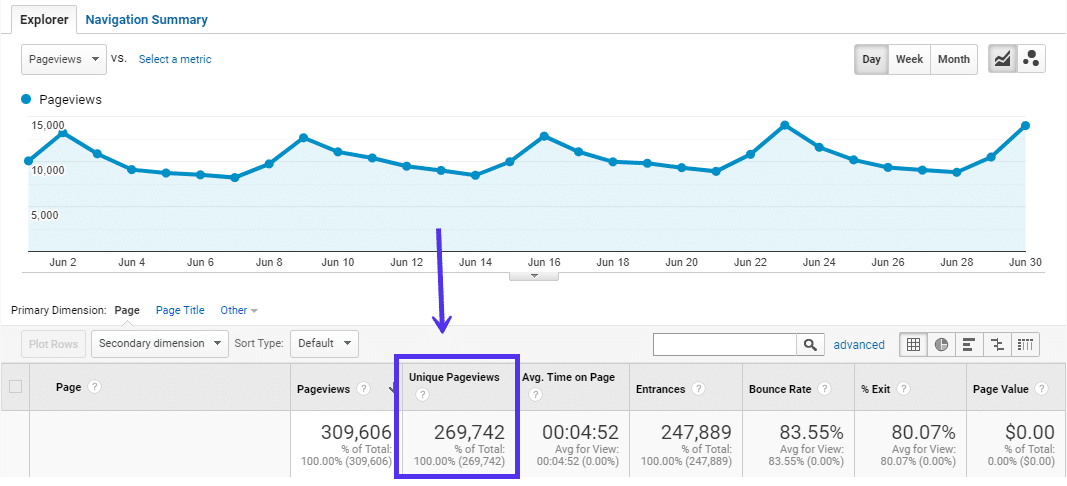
That screenshot is from one of my sites called The Wandering RV. My wife and I grew this site from a brand new site to a quarter million monthly visits in just three years with less than 30 articles.
Yes, you also have to create great content and build links to that content, but those actions come AFTER you know the best keywords to target. Every successful SEO campaign begins with keyword research; skip this step at your peril.
Ready to get started?
How to Do Keyword Research (Quick Steps):
Good keywords make or brake a successful SEO marketing campaign. Here’s the key steps to get started with keyword research:
Step 1: Find keyword ideas based on key terms, related search, long-tail keywords, and LSI.
Step 2: Check the TRUE keyword difficulty and search volume.
Step 3: Determine user intent.
In today’s guide, I share a step-by-step guide to keyword research that covers not just how to find hundreds of great keywords, but also how to tell which ones can move the needle for your business and which aren’t worth your time. Let’s dive in!
Keyword Research Fundamentals
Before I talk about the exact steps to find keywords for your SEO campaign, let’s briefly cover what keyword research is and why you should care.
What Is Keyword Research?
Keyword research is the act of finding and vetting keywords to target in an SEO campaign.
This is done using a number of free and/or paid tools that show you what people are searching for on Google and other search engines.
Suggested in-depth guides: Google Search Console and Bing Webmaster Tools.
The Role of Keyword Research in Digital Marketing
As you’ll learn in the next section, the quality of your keywords is the difference between a successful marketing campaign and a waste of time. The keywords you pick will determine your SEO marketing strategy from beginning to end.
Let’s see how.
How Important is Keyword Research? (Don’t Skip This!)
SEO can be complex, but it boils down to three fundamentals:
- Keyword Research
- Content
- Link building
Of those three, keyword research is the most important.
Why? Because you can create the best content and build incredible links that score you #1 Google rankings and still get zero benefits in terms of business growth or revenue if you target the wrong keywords.
For example, let’s say you want to write some content on your site’s blog so you can show up on Google’s first page. You have an idea of a blog post and think you have a good keyword to target. You make amazing content, build links to it through guest posting and email outreach (here’s how to find anyone’s email address), and end up on the first page of Google. You’re getting hundreds of visits every month…
But your income from that article remains a big fat $0.
That’s because you didn’t properly research your keyword ahead of time. You may have found a keyword, but finding a keyword and doing keyword research are very different things.
Properly researching a keyword means understanding it’s income potential, how competitive it is, and even the exact kind of content you need to create to be able to rank for it. You’ll see what I mean by the end of this guide.
In a nutshell: Proper keyword research can be the difference between a wildly successful SEO campaign that makes your business tons of money and an utter waste of time and money.
Search Volume and Long Tail Keywords
The first concept to understand about keywords is search volume.
This is what most people look at when they first start researching keywords, and also one of the worst metrics to look at.
A high search volume is very deceiving for two reasons:
- The raw number of people searching for something has very little to do with how much you can actually earn from that traffic. For example, if you rank for a keyword that gets 10,000 searches per month, but if people are just looking for information and aren’t ready to buy (hint: you’d need to define the search intent. More below.), that does nothing for your bottom line.
- Just because 10,000 people search for a keyword doesn’t mean all 10,000 people actually click on a result. Take a look at the keyword “How old is Biden”, for example—it gets 51,000 searches per month, but only 17% of those people actually click on anything. That’s because people get the answer right on Google and don’t need to click through to find it.
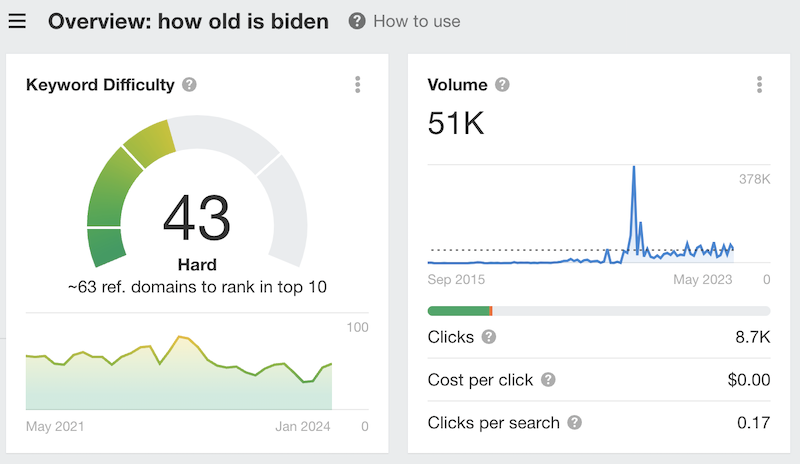

On the other hand, a low search volume doesn’t mean a keyword is bad or that the number you see is the number of visitors you’ll get. Virtually all pages that rank on Google for one keyword also rank for dozens, hundreds, and sometimes thousands of other keywords.
These other keywords are usually synonyms and long-tail variants. There are also Latent Semantic Indexing (LSI) keywords, which I get to in a section below.
For example, take a look at this post that my wife, Kayla, wrote for The Wandering RV. She was targeting the keyword “best camping gear”, which gets around 2,700 searches per month according to Ahrefs. But as you can see in the screenshot below, it also ranks for 1,912 other keywords and even ranks on page one for “camping gear” at 32,000 searches per month!

The point of the story? While search volume is an important metric, you shouldn’t base your target keywords solely on how many people are searching for it every month (unless you’re only focused on brand awareness and/or advertising revenue on a per-impression basis).
Search Intent
Search intent is exactly what it sounds like—the intent of the person searching for a given keyword. It’s similar to the marketing concept “buyer intent”.
In other words: What is the user looking for?
Are they searching for an item they are ready to buy right now? Are they doing research before they make a purchase decision? Or are they just looking for information that has nothing to do with buying anything, but rather with a problem they may need a solution to?
Let’s look at an example of each.
High Buying Intent: A high buying intent keyword may be a product name, such as “RV rental las vegas”. If you type that into Google and look at the results, you see a bunch of ads for RV rentals and a map showing Las Vegas RV rental companies. Someone searching this is likely ready to buy, or very close.
![High Search Intent]](https://kinsta.com/wp-content/uploads/2019/07/High-Search-Intent.png)
Research Intent: These are keywords where people are still doing research on solutions, but will likely buy soon. “Best” and “Review” keywords often fall into this category, such as “best RV rental companies”.
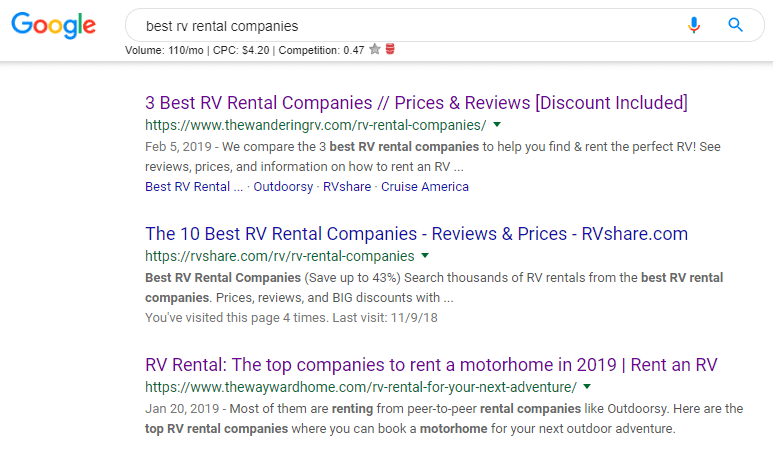
Informational Intent: These keywords are for people strictly looking for information and aren’t ready or even thinking about buying anything. The “how old is Biden” example falls under this category. Another example that fits with RV rentals might be something like “how to travel the country with a pet”.
However, don’t think that you should only go after buying intent keywords. Informational keywords can help you build your email list and get people into your marketing funnel to eventually buy from you.
Search intent is also important to know because it affects what content ranks on Google. If you try to create a landing page to rank for an informational keyword when Google is ranking long-form blog content, you probably won’t rank even with perfect on-page SEO and plenty of backlinks because it’s simply not what the user is searching for.
For example, let’s say you want to rank for “small campers”. So you create a guide to owning small campers. However, when we look at Google, we can see that people aren’t looking for a guide, but rather, they’re looking for a list of small campers to buy.
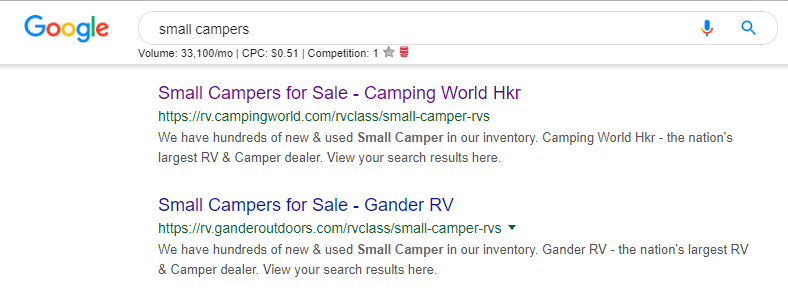
That’s why even after you find good keyword ideas, you should always manually type them into Google and see what’s currently ranking to get an idea of what you need to create. Don’t write a massive guide when people just want a quick answer and don’t try to rank a blog post when people are looking to buy a product.
The Role of LSI and Synonyms
Earlier, I mentioned LSI keywords. This stands for Latent Semantic Indexing, and it’s a fancy way for Google to say “synonyms and related keywords”. They’re words that are commonly found together within a single topic and are semantically related to each other.
They’re important to tell the search engines what your content is about since there can be multiple meanings to the same keywords.
For example, let’s say you’re writing an article about cars. There are five different potential “cars” you could be talking about:
- Cars, the vehicles
- Cars, the animated Disney movie
- CARS, the Canadian Association for Rally Sports
- CARs, the Canadian Aviation Regulations
- (The) Cars, the American 1970s music band
How does Google know which version of “cars” you’re talking about? By LSI keywords! Take a look:
- Using the words “vehicle”, “used”, “new”, “buy”, “sell”, etc.
- Using the words “film”, “movie”, “Disney”, etc.
- Using the words “association”, “rally”, “sports”, etc.
- Using the words “aviation”, “regulation”, “administration”, etc.
While LSI keywords don’t necessarily matter during your keyword research, they are important when developing your actual content. You should include various LSI keywords naturally in your content without stuffing them, including in headings and image alt text.
You can find LSI keywords (and learn more about them) with a tool like LSI Graph.
How Do You Do Keyword Research? (Step-by-Step Guide)
Alright, now that you have a firm understanding of the important metrics behind keyword research, it’s time to actually find your very own keywords! There are three steps I follow when I’m doing keyword research for a new site, with an optional, more advanced fourth step:
- Find keyword ideas
- Check the TRUE keyword difficulty and search volume
- Determine their search intent
- (Optional) Find & utilize keyword silos
Let’s dive in!
Step 1: Find Keyword Ideas
Finding keyword ideas is the easy part. There are loads of tools that will spit out hundreds of ideas at the click of a button. It’s vetting them that takes effort, but we’ll get to that.
For now, go take a look at the “Best Keyword Research Tool” section below and pick your poison. I’ll be using Ahrefs in the examples because it’s my favorite tool and has all the bells and whistles, but the other tools can work as well.
My favorite way to find great keyword opportunities is spying on my competition. You can do this by plugging their site into any keyword tool and look at their keywords. Ahrefs has a nifty tool called the Content Gap Analysis.
Here’s how it works:
1. Plug your site into Ahrefs, then click the Content Gap link in the left-hand menu.
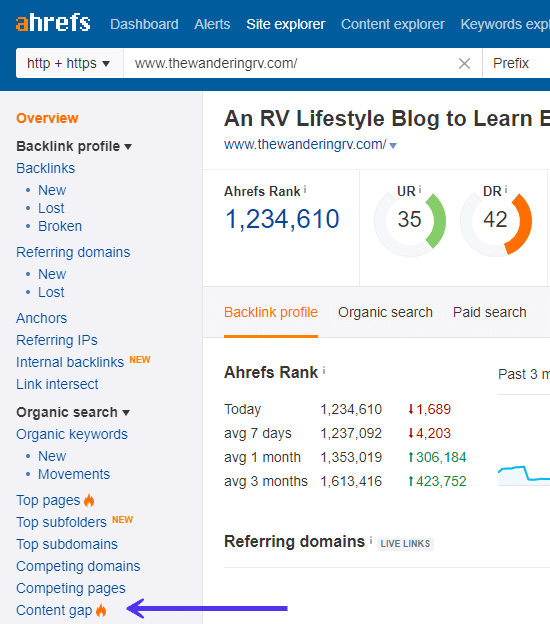
2. Plug in 1-10 competitors who are ranking on Google for keywords you want to rank for. You can find them by Googling those keywords and grabbing the URLs off of Google or by using Ahrefs’ Competing domains tool right above the Content gap link. Run the tool.
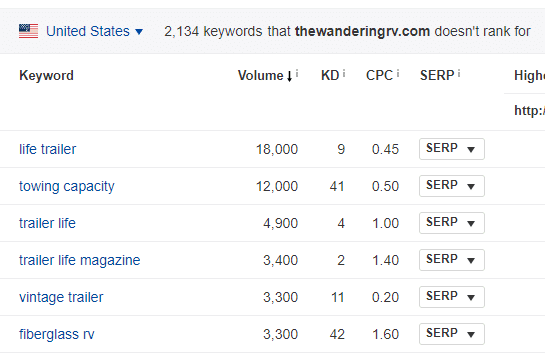
3. From here, you can export the list to an excel spreadsheet if you want. I like to comb through the list right in Ahrefs. If I see a keyword I might want to target, I open it in a new tab and add it to a keyword list using the + Add to button in the top right.

If you don’t have access to Ahrefs or another keyword tool that allows you to see competitor’s keywords, you can also use a tool like Keyword Shitter to give you a ton of ideas, then vet them using other free tools such as Uber Suggest.
Step 2: Check The TRUE Keyword Difficulty and Search Volume
Once you have a list of keyword ideas you’re comfortable working with (I aim for 50-100 at a time but you can do far more), it’s time to see which are even worth pursuing based on keyword difficulty (KD) and search volume.
There’s just one caveat… the search volume and KD you see in most keyword research tools are usually way off. KD in Ahrefs is solely based off the number of linking domains to the top results, which isn’t a 100% accurate depiction of the true difficulty to rank for a keyword.
This is because SEO is a complex beast, and things like domain rating (which I’ll cover shortly) and internal linking can have a massive impact on rankings. Backlinks are only part of the picture.
And the search volume? That’s not including LSI and long-tail keywords!
Remember that camping gear example I showed you at the beginning of this article that ranks for over 1,900 keywords? The main keyword only had 2,700 searches per month, yet the article gets over 5,000 visits per month. That’s because it’s ranking for other keywords besides the main keyword.
So if you see a keyword with 200 searches per month, chances are it’s really more like 500 or 1,000 if you include the related keywords that you’ll rank for.
To determine true search volume, grab the #1 result on Google for the keyword and plug it into Ahrefs or Uber Suggest to see how much traffic that page actually gets. That should give you a more accurate picture of the search volume for a given keyword.
Here’s the traffic for the #1 ranking page for “tiny campers”, a keyword that gets ~3,400 searches per month:

See how the page gets over 10k traffic, despite the main keyword getting a third of that? That’s true search volume potential.
The other metric, keyword difficulty, is also not 100% accurate. But figuring out true difficulty is usually as easy as looking at the top pages domain authority (DA), or domain rating (DR) if you’re using Ahrefs. Let me explain.
If a keyword has a difficulty score of 8, but the top ranking pages are all DR 80+, ranking your site for those keywords may be difficult if you have a low DR, despite the low difficulty score.
My advice is to aim for keywords with a 30 KD or lower if you’re under a 40 DR, then branch up as you build more links and gain a higher authority. As your DR climbs, your internal links are worth more “link juice” (or pass more “page authority” depending on what source you listen to).
But this isn’t an article on technical SEO, so I’ll leave it at that for now!
Step 3: Determine Search Intent
At this point, you should have a pretty decent list of keywords with a difficulty you’re comfortable tackling and a search volume potential you’d be happy to capture. Now it’s time to figure out what people actually want when they search for these terms and whether or not it fits in with your marketing and revenue goals.
This part is as simple as Googling each keyword on your list and looking at the top 3-5 results. Review their meta title and description, click on them to view the page, and check out the angle they took on the page.
- Are they mainly listicle posts? How-tos? Ultimate guides? A landing page? Something else?
- How do they seem to be monetizing the page? Are they using display ads? Selling products as a solution to the problem? Affiliate marketing? Just capturing emails and not actually selling anything?
- Take a look at the comments. Are people asking questions that weren’t answered in the article? Do they seem happy, angry, or neutral?
All of these questions will help you dial in on the type of post/page you need to create, how you can monetize it (or use it to capture emails/push notification subscribers/social followers), and what you can do to improve it.
As you’re going through each keyword, keep your answers to these questions in a spreadsheet or word document to keep track of which ones you’re interested in pursuing. Your final list is the list you can start pursuing!
To give you a better idea of how to determine search intent, here are a few examples courtesy of this Moz post:
Informational Intent:
- [product name]
- what is [product name]
- how does [product name] work
- how do I use [product name]
Commercial Intent (AKA Research Intent):
- best [product name]
- [product name] reviews
- compare [product name]
- what is the top [product name]
- [colour/style/size] [product name]
Transactional Intent (AKA Buying Intent):
- how much does [product name] cost
- [product name] in [location]
- order [product name] online
- [product name] near me
- affordable [brand name] [product name]
This graph from Ahrefs may also help:
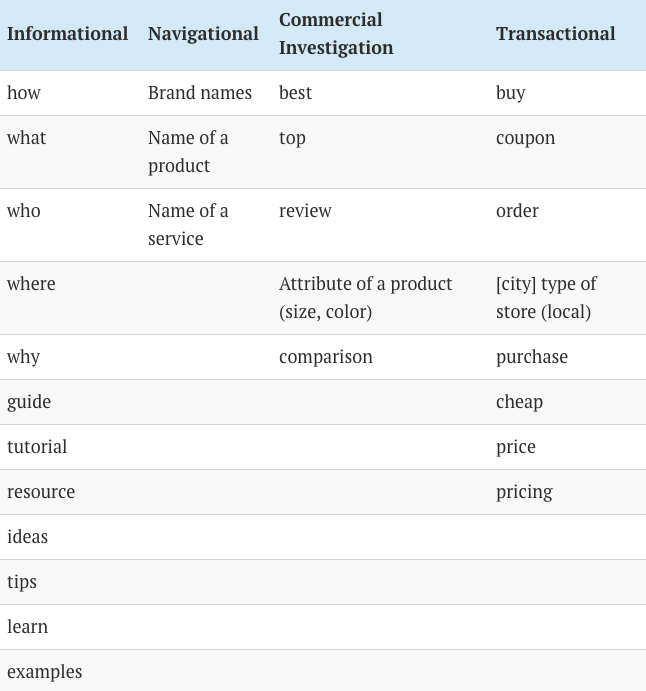
Now take your list and go crank out some content! Or, you can follow one last step.
Step 4: (Advanced) Find & Utilize Keyword Silos
If you really want to do well, you can optionally take it one step further and look for keyword silos to create corresponding content silos on your site.
A keyword silo is a list of highly related keywords that you can create content around to interlink between on your site (also called the “hub and spoke” method). Here’s a visual I created to help you understand:
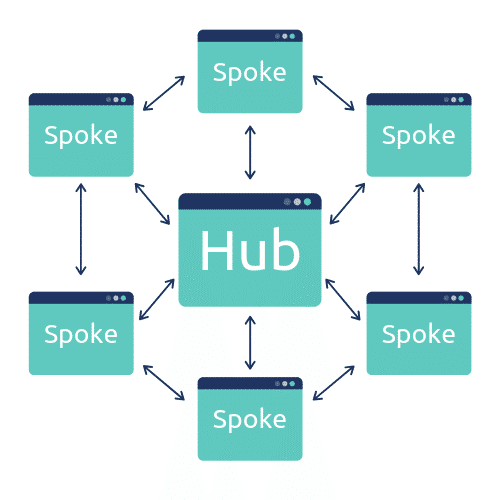
Essentially, you create a hub page targeting the primary head term you want to rank for, then create “spoke” pages based on related and long-tail keywords.
For example, while doing keyword research for my wife Kayla’s vegan food blog, I found a series of related keywords asking “Is ___ vegan”. People wanted to know if common foods, such as bagels, donuts, or Oreos are vegan.
To rank for these keywords, we created this hub page which links to all of her “Is ___ vegan” articles. These articles all link to one another, as well as back to the main hub page.
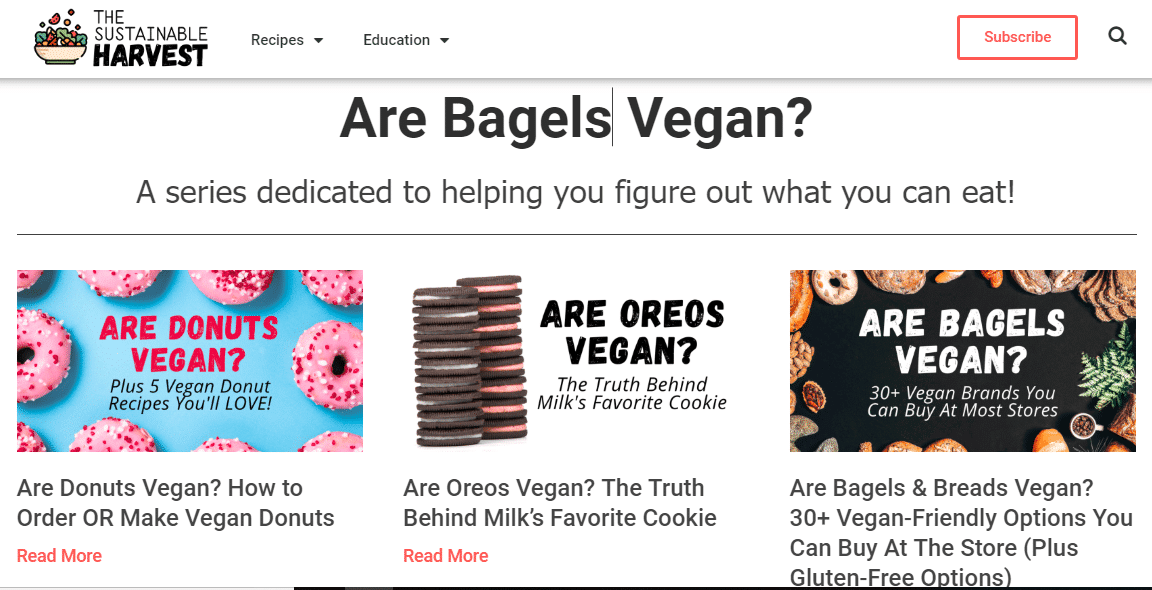
This inter-linking is called content siloing, and it works so well for two reasons:
- Because all the pages interlink to one another, if you build links to any of the pages, it improves page authority across all of the other pages.
- Google uses relevancy in its algorithm, and since these topics are all highly relevant to one another, it can improve your rankings further.
So how do you find keyword silos? There is no silver bullet solution — you have to be good at picking up on patterns and noticing relevancy. However, there is one trick you can use to try and find them: books.
Look for books on your topic on Amazon and browse the table of contents. Oftentimes, books are full of keyword silos: that’s what makes them a book! Think of the binding as the hub page and the chapters as the spoke pages.
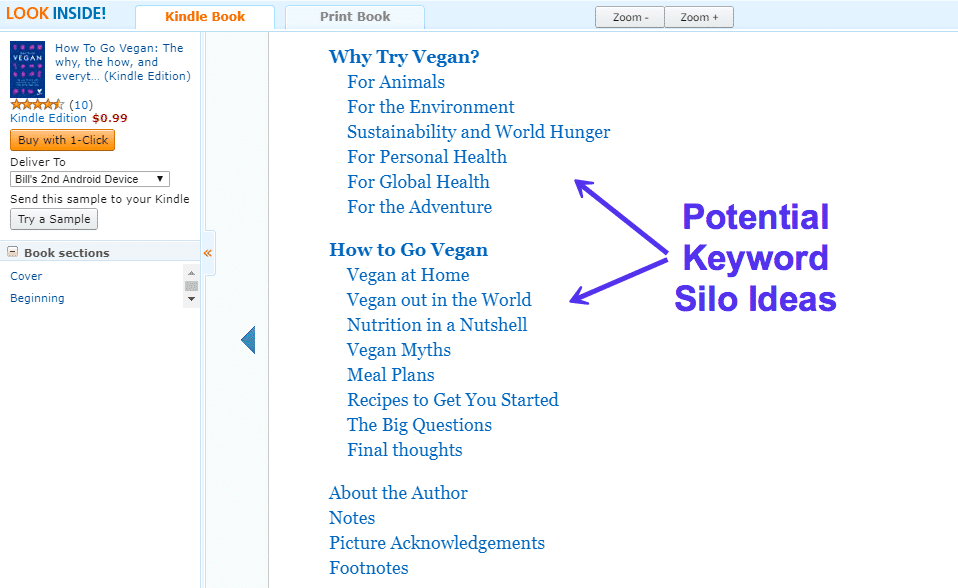
Of course, as you can see in the example above, these keywords aren’t exactly what people are searching for on Google. People aren’t typing “vegan out in the world”, but rather “how to eat vegan at restaurants” or “how to eat vegan at family gatherings”. So you may have to do some sleuthing to figure out the keyword that corresponds with the chapter title in the books you find.
Once you find a potential silo, be sure to run the keywords through steps 2 and 3 before you commit to it! Just because you found a silo, doesn’t mean you should pursue it. Think logically about how all that content will fit into your business and how you can expand on it in the future.
What Is The Best Keyword Research Tool?
There are dozens, if not hundreds of keyword research tools on the market today. Some are extremely unique, but most are just slightly different takes on the same idea. So what’s the best one? Let’s break it down by free and paid tools.
Free Keyword Research Tools
There are two free keyword research tools I’ve used and recommend:
- Ubersuggest
- Keyword Shitter
Ubersuggest
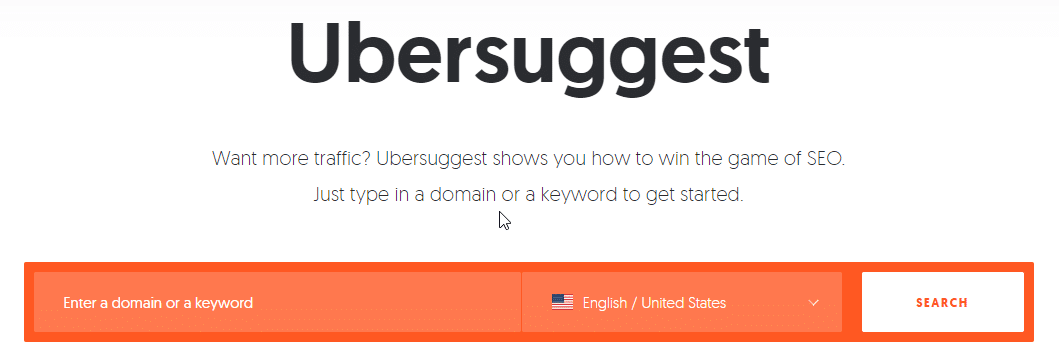
Let’s put on hold all the conversions about Neil Patel for a second. This tool does its job and, if you’re on a budget, it can work to get you started with SEO.
Ubersuggest is basically a free, scaled-down version of Ahrefs or Moz. It lets you spy on competitor’s backlinks, see what keywords they’re ranking for, and do some decent keyword research. If you’re doing SEO on a budget, it can get the job done.
Keyword Shitter
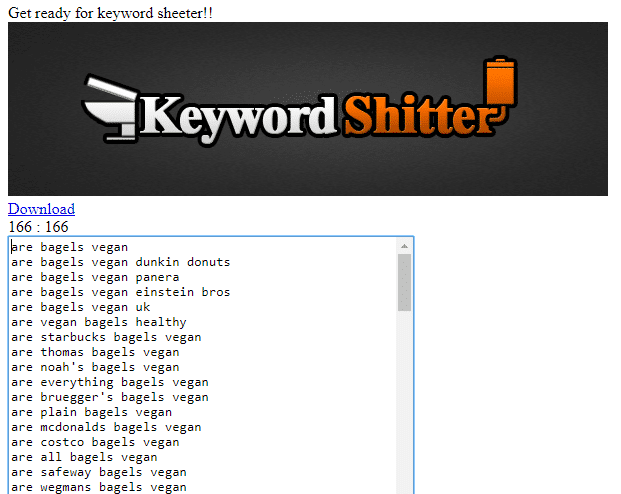
Keyword Shitter is pretty much exactly what it sounds like. You type in a keyword and get hundreds of keyword suggestions. It’s great if you just need tons of ideas, but it mostly only spits out related keywords to the one you typed in, not unique, separate ideas.
Paid Keyword Research Tools
Now we’re getting into the big-boy (or girl) tools! If you’re serious about SEO and you have the budget, these are the tools you want to use.
- Ahrefs
- SEMrush
- Keyword Insights
- Keywords Everywhere
Ahrefs

Ahrefs is hands-down my favorite SEO tool; not just for keyword research, but also for link-building, rank tracking, coming up with content ideas, and more. It has all the bells and whistles and is easily the best all-around SEO tool on the market. However, it comes at a steep price, with just the basic tool being $99 per month.
SEMrush
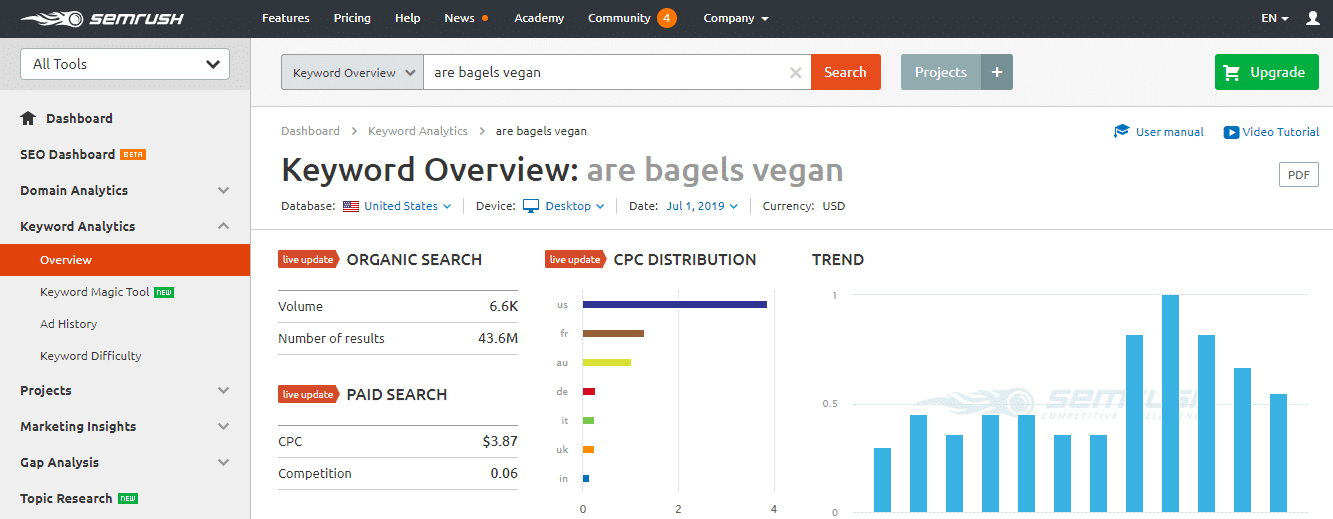
SEMrush is another great keyword research tool. It’s more affordable than Ahrefs, but it doesn’t have quite as many features. It’s more geared towards search engine marketing and PPC (thus the SEM in SEMrush). However, if you want a great paid tool but don’t want to pay the premium on Ahrefs, it’s a valid option. It even lets you try out the product for free!
Keyword Insights
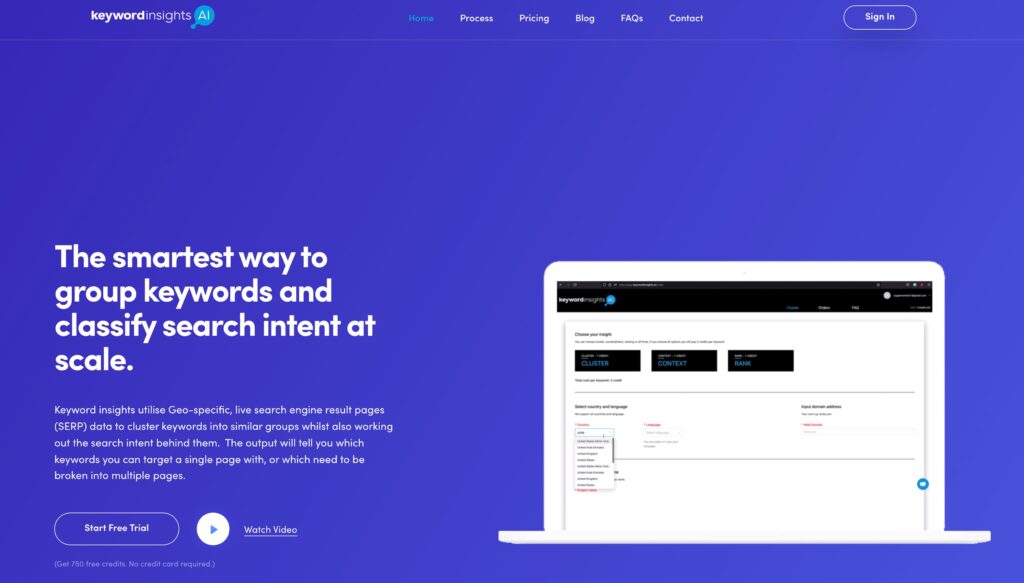
Keyword Insights claims to be “the smartest way to group keywords and classify search intent at scale”… and with good reason. The tool utilizes geo-specific, live search engine result page data to cluster keywords into similar groups whilst also working out the search intent behind them.
A user simply uploads a list of keywords (as many as you’d like) and the tool will spit out a preformatted Google sheets document with the clustered keywords and the intent pulled through. Its most recent update also sorts the grouped keywords into “top-level themes” so you can see what their content hubs should be and what their spoke content might look like. The insights will also tell you which keywords you can target a single page with, or which need to be broken into multiple pages.
Keywords Everywhere
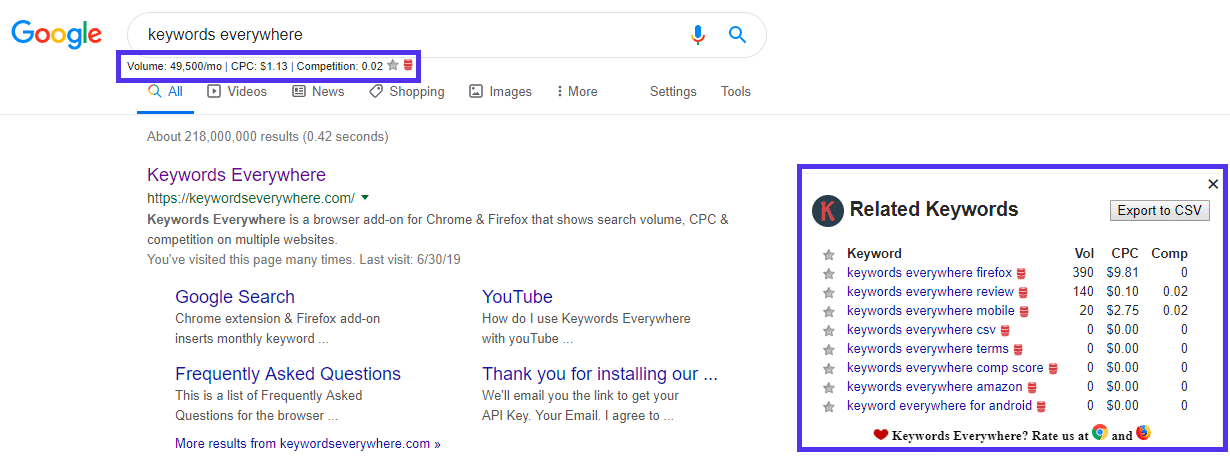
Keywords Everywhere is an awesome tool that used to be free and now is credit-based. The tool shows you search volume, competition, and average CPC right on Google whenever you type something in. It also shows you stats on related keywords and the “people also search” keywords. Regardless of which other tools you use, I highly recommend grabbing this one.
Want more SEO tools? Check out Kinsta’s list of must-have SEO plugins for WordPress.
Suggested Stack
So what keyword research tools should you get? My suggested stack is Ahrefs and Keywords Everywhere. Ahrefs is a complete SEO software that will help you rank your site, not just find keywords. And Keywords Everywhere lets you see search volume and keyword ideas any time you’re searching something on Google. Plus it’s free, so what’s not to like?
Summary
Here’s a quick recap of everything we’ve covered:
- Keyword research is extremely important to any SEO campaign and should not be skipped or taken lightly.
- Search volume and keyword difficulty can be deceiving. Do some deeper research by typing the keyword into Google and reviewing the results before you make a decision.
- Don’t be fooled by low search volume. Check the true search volume by reviewing the top pages search traffic using Ubersuggest or Ahrefs.
- Search intent is king. Make sure the content you’re creating matches the content people want to see (and what Google is already showing).
- Look for keyword silos. They’re can be a shortcut to ranking your pages faster.
And that’s all there is to it! If you have any questions, feel free to drop a comment below or shoot me an email. For more help with SEO, click here to read my step-by-step guide and this awesome in-depth guide on how to drive more traffic to your website.
Good luck!



Keyword Research is predominantly a statistical analysis of trending interests that are expressed by internet searches.
Although I realize the importance of said statistics, I am “right brained” and have struggled with being interested in numbers, all of my life. When I look at a keyword research result, the numbers tell me nothing in terms that I can understand. In fact, I’m totally bored by the concept.
I have read many posts, papers, and websites about the subject, and although not many agree with the same approach, they basically are saying the same things. b-o-r-i-n-g!
What is stopping a keyword research tool (once the stats have been gathered) from asking what it is that you sell, and then saying… well, to sell that, try concentrating on this…, and spare me the statistical analysis.
Really helpful article. Especially for the newcomers who want to be an SEO expert.
Thanks, Eva! Glad you enjoyed it. :)
What if I’m a business owner with a brand new site with no blog posts yet? How would I start this if I’m new to KW research? Are there services (real people services) that help with this or do it with me?
Hey, Johnny!
No problem! The steps with the content gap analysis are the same – you just have to manually find your competitors rather than using a tool. To do that, Google some keywords you think you want to rank for and grab the URLs of the top-ranking sites that monetize their sites similarly to you (whether that’s through ads, affiliate marketing, or selling similar products).
Paste those URLs into the content gap tool and follow along from there! Hope this helps! :)
Awesome! i am using this article to share with my students while i m teaching keyword research.
Hey Bill!
Lots of great information here ! Just wanting to introduce to a free alternative to Keywords everywhere, a chrome extension – WhatsmySERP.com/everywhere it gives you unlimited searches for volume and CPC.
Our team has launched this tool and it already has 5 star reviews and 20k+ users. I’d love for you to try it and see what your thoughts are.
I’d love to know your thoughts :)
This article is really really helpful for the newcomers. specially the one who recently started a blog or a website and Also, wants to Learn SEO.
The thing with the search intent is really important!
This was really what i was searching. perfect timing, thanks Bill such an valuable post.